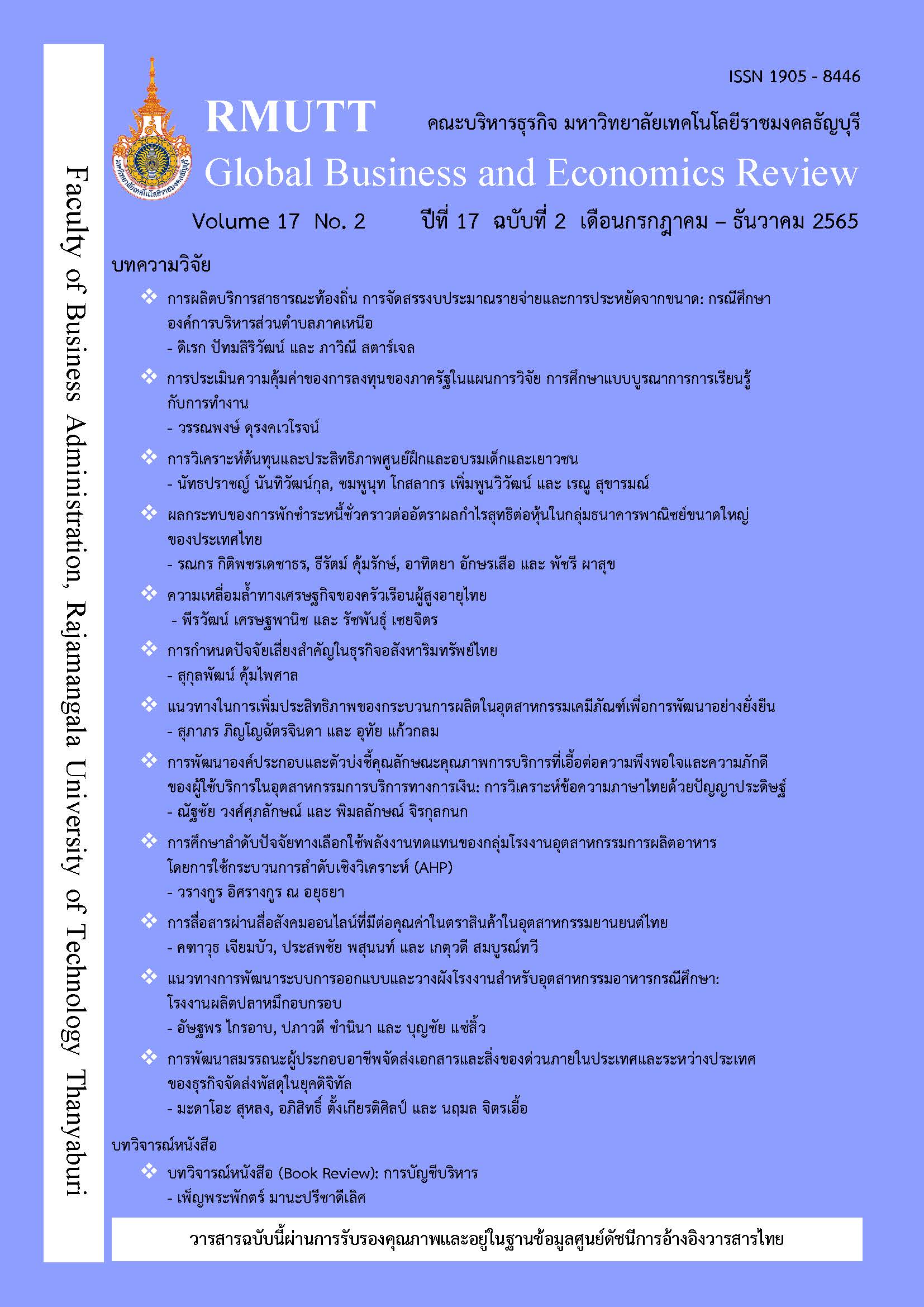AN ASSESSMENT OF PUBLIC INVESTMENT ON WORK-INTEGRATED LEARNING RESEARCH PROJECTS
Keywords:
Work-Integrated Learning, , Education, Industrial Sector, Social Return On InvestmentAbstract
The purpose of this study is to investigate economic impacts of public investment on the work-integrated learning (WIL) research program. Research program on WIL aims to develop innovative model in upgrading study curricula which integrates in-class learning and working experiences between educational institutions and industries. Research methodology is an ex-ante calculation of the social return on investment (SROI) under different scenarios. The Cobb-Douglas production function is estimated using time-series annual data from 1991 to 2018. The results show that investment on this research program has high economic return. This investment can generate economic impacts between 70 and 4,400 million baht, and its SROI ranges between 0.56 and 35.88. The upshot is that two factors that can increase its net benefit are an increase in participation of educational institutions (Vocational institute and university) and the share of fresh graduate working in manufacturing sector.
References
กษิรา กาญจนพิบูลย์ และ ธนาสิทธิ์ เพิ่มเพียร. (2559). แนวทางปฏิบัติตามแนวการจัดการศึกษาเชิงบูรณาการกับการทำงานที่เหมาะสมกับคุณลักษณะที่พึงประสงค์ของนักศึกษาหลักสูตรบริหารธุรกิจบัณฑิตและความต้องการของสถานประกอบการ. วารสารปัญญาภิวัฒน์, 8(3), 165-177.
จิระเสกข์ ตรีเมธสุนทร. (2563). ปัจจัยสู่ความสำเร็จของการบูรณาการการเรียนรู้กับการทำงานระหว่างสถาบันอุดมศึกษากับสถานประกอบการในการพัฒนาด้านสมรรถนะของพนักงานฝ่ายผลิตในนิคมอุตสาหกรรมภาคตะวันออก. วารสารวิชาการเซาธ์อีสท์บางกอก (สาขามนุษยศาสตร์และสังคมศาสตร์), 6(1), 50-61.
ไชยยะ คงมณี, พลากร สัตย์ซื่อ และ ปุรวิชญ์ พิทยาภินันท์. (2561). ผลตอบแทนทางสังคมจากการลงทุนของโครงการวิจัยทางวิทยาศาสตร์ในชุดโครงการการพัฒนาอุตสาหกรรมยางพารา. วารสารการจัดการสมัยใหม่, 16(2), 44-56.
ปราโมทย์ สิทธิจักร และ วิไรวรรณ แสนชะนะ. (2560). การพัฒนาระบบจัดการเรียนรู้แบบบูรณาการเครือข่ายสังคมออนไลน์ สำหรับหลักสูตรท้องถิ่นผ่านอุปกรณ์เคลื่อนที่. วารสารเทคโนโลยีสุรนารี, 11(2), 59-82.
ปานเพชร ชินินทร และวิเชษฐ์ พลายมาศ. (2553). การศึกษาปัจจัยสู่ความสำเร็จของการจัดการศึกษาเชิงบูรณาการกับการทำงานสำหรับอุดมศึกษาไทย (Work Integrated Learning: WIL). ใน รายงานการประชุมวิชาการครั้งที่ 7 มหาวิทยาลัยเกษตรศาสตร์ วิทยาเขตกำแพงแสน คณะวิทยาศาสตร์และสิ่งแวดล้อม (น. 1056-1063). กรุงเทพฯ: มหาวิทยาลัยเกษตรศาสตร์.
วรรณพงษ์ ดุรงคเวโรจน์. (2564). ผลกระทบของการเรียนการสอนในวิถีใหม่ต่อนักศึกษาระดับอุดมศึกษา: กรณีศึกษา นักศึกษามหาวิทยาลัยรามคำแหง. วารสารเศรษฐศาสตร์และนโยบายสาธารณะ, 12(23), 36-54.
วลีรัตน์ สุพรรณชาติ. (2562). ผลตอบแทนจากการลงทุนวิจัยและพัฒนาด้านการเกษตรของภาครัฐและเอกชนในประเทศไทย. แก่นเกษตร, 47(5), 1077-1088.
สำนักงานเลขาธิการสภาการศึกษา. (2552). รายงานการวิจัยฉบับสมบูรณ์เรื่อง การพัฒนาแนวทางการจัดการเรียนการสอนที่บูรณาการการเรียนรู้กับการทำงานในสถาบันอุดมศึกษา (Work-Integrated Learning). กรุงเทพฯ: สำนักงานเลขาธิการสภาการศึกษา กระทรวงศึกษาธิการ.
สุริยะ พุ่มเฉลิม และ พัลลภ พิริยะสุรวงศ์. (2558). การออกแบบรูปแบบการจัดการศึกษาแบบบูรณาการการเรียนกับการทำงาน โดยใช้เทคโนโลยีสารสนเทศของสถาบันอุดมศึกษา. วารสารวิชาการครุศาสตร์อุตสาหกรรม พระจอมเกล้าพระนครเหนือ, 6(2), 49-57.
อลงกต ยะไวทย์. (2559). การสอนในมหาวิทยาลัยทำไมต้องเป็น WIL. เอกสารประกอบการบรรยาย, สืบค้นจาก http://coop.tsu.ac.th/UserFiles/file/information/knowledgeWIL.pdf
Aucejo, E. M., French, J., Araya, M. P. U., & Zafar, B. (2020). The impact of COVID-19 on student experiences and expectations: Evidence from a survey. Journal of Public Economics, 191.
Casado-Aranda, L.-A., Sanchez-Fernandez, J., Montoro-Rios, F. J., & Horcajadas, M. I. A. (2021). Evaluation of the work-integrated learning methodology: Teaching marketing through practitioner experience in the classroom. Mathematics, 9(17), 2164.
de Vries, G., Arfelt, L., Drees, D., Godemann, M., Hamilton, C., Jessen-Thiesen, B., Kaya, A. I., Kruse, H., Mensah, E., & Woltjer, P. (2021). The Economic Transformation Database (ETC): Content, Sources, and Methods. WIDER Technical Note 2/2021.
Jackson, D. (2015). Employability skill development in work-integrated learning: Barriers and best practice. Studies in higher education, 40(2), 350-367.
Jackson, D., & Wilton, N. (2016). Developing career management competencies among undergraduates and the role of work-integrated learning. Teaching in Higher Education, 21(3), 266-286.
Jitsuchon, S. (2012). Thailand in a middle-income trap. TDRI Quarterly Review, 27(2), 13-20.
OECD. (2020). Thailand’s education system and skills imbalances: Assessment and policy recommendations. Economics Department Working Series No. 1641.
Rybnicek, R., & Konigsgruber, R. (2019). What makes industry-university collaboration succeed? A systematic review of the literature. Journal of Business Economics, 89, 221-250.
Smith, C. (2012). Evaluating the quality of work-integrated learning curricula: A comprehensive framework. Higher Education Research and Development, 31(2), 247-262.
Timmer, M. P., de Vries, G. J., and de Vries, K. (2015). Patterns of structural change in developing countries. In J. Weiss, & M. Tribe (Eds.), Routledge Handbook of Industry and Development (pp. 65-83). London: Routledge.
Warr, P. (1993). The Thai economy. In P. Warr (Ed.). The Thai Economy in Transition. Cambridge: Cambridge University Press.
Warr, P. G. (2019). Economic development of post-war Thailand. In: P. Chachavalpongun (ed.). Routledge Handbook of Contemporary Thailand. London: Routledge.
Downloads
Published
How to Cite
Issue
Section
License
Copyright (c) 2022 วรรณพงษ์ ดุรงคเวโรจน์

This work is licensed under a Creative Commons Attribution-NonCommercial-NoDerivatives 4.0 International License.
The articles published in this journal are the intellectual property of their respective authors.
The views and opinions expressed in each article are solely those of the individual authors and do not reflect the positions of Rajamangala University of Technology Thanyaburi or any of its faculty members. All components and content of each article are the sole responsibility of the respective authors. In the event of any errors, the authors shall bear full responsibility for their own work.








